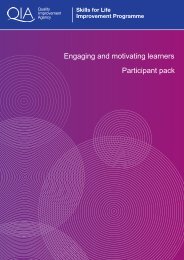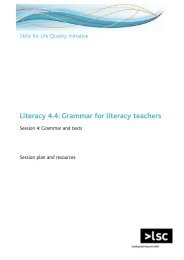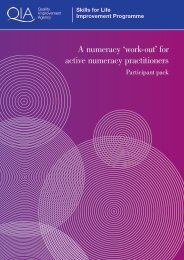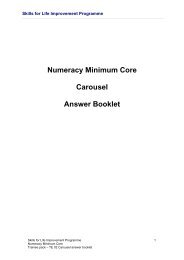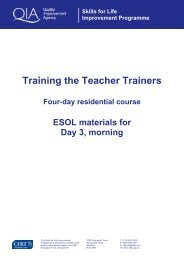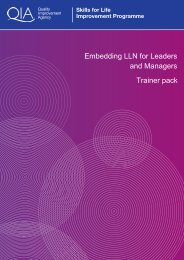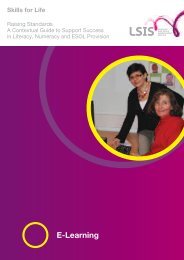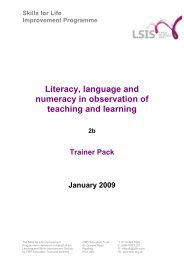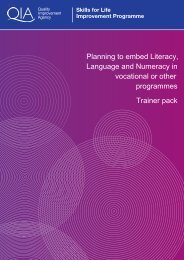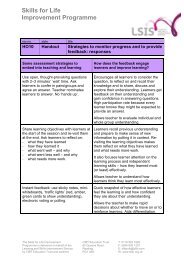Skills for Life Improvement Programme - SfLIP - Excellence Gateway
Skills for Life Improvement Programme - SfLIP - Excellence Gateway
Skills for Life Improvement Programme - SfLIP - Excellence Gateway
Create successful ePaper yourself
Turn your PDF publications into a flip-book with our unique Google optimized e-Paper software.
<strong>Skills</strong> <strong>for</strong> <strong>Life</strong> <strong>Improvement</strong> <strong>Programme</strong><br />
res no. style title<br />
TN3 Trainer Notes Adapting Resources<br />
Show participants PP15 to remind them that LLN skills levels match vocational levels.<br />
Ask if they know their learners’ assessed literacy and numeracy levels.<br />
Ask if they use this knowledge of their learners’ skills levels when planning sessions.<br />
Refer to CPD chart and point out Module 4a - Assessing learners’ needs/strengths<br />
and target-setting.<br />
Why do we need to adapt resources<br />
NB to trainer: it might be valuable to use participants’ own resources relating to their<br />
vocational area in this activity. If you do, be sensitive to participants’ feelings and use<br />
more than one resource as exemplars. Follow instructions as given <strong>for</strong> HO4 Hazards.<br />
Ask the participants to skim read HO4 Hazard signs and symbols that has been<br />
taken from the Trowel Occupations Embedded Learning Materials pages 33-34.<br />
Give them five minutes to work in their groups, to list on a flipchart or whiteboard the<br />
barriers there might typically be <strong>for</strong> their learners in reading, understanding and<br />
memorising the kind of in<strong>for</strong>mation on this handout.<br />
Ask volunteers to share in the whole group, taking an idea from each table in turn.<br />
Elicit these types of barriers:<br />
• The dense nature of the in<strong>for</strong>mation – may be too much on one page<br />
• Reading and understanding the facts may be too hard because:<br />
o there are long words to decode e.g. contaminated<br />
o some words/phrases may not be known to them e.g. static discharge<br />
• Some read very slowly because they don’t know how to scan in<strong>for</strong>mation<br />
• Some may have poor memorising strategies<br />
• Some may get bored and switch off.<br />
Adapting resources<br />
Prepare 4 sheets of flipchart paper with headings 1-4 as below.<br />
Show PP16 and ask participants to work in pairs to suggest ways they could teach<br />
the hazard signs and symbols shown on HO4 (or their own resource) to make<br />
learning more successful <strong>for</strong> these four learners:



